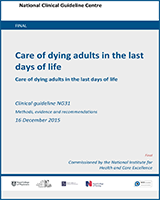From: 5, Recognising when a person may be in the last days of life

Care of Dying Adults in the Last Days of Life.
NICE Guideline, No. 31.
National Clinical Guideline Centre (UK).
London: National Institute for Health and Care Excellence (NICE); 2015 Dec 16.
Copyright © 2015 National Clinical Guideline Centre.
NCBI Bookshelf. A service of the National Library of Medicine, National Institutes of Health.